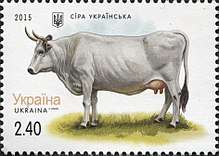Ukrainian Grey
The Ukrainian Grey (Ukrainian: Сіра українська порода, Sira ukrayin'ska) is an ancient breed of Podolian cattle from Ukraine.[3] This hardy breed has been used for meat and draught power, and is similar to other European steppe cattle breeds such as the Hungarian Grey and the Italian Podolica.
 Illustration on a postage stamp | |
| Conservation status | FAO (2007): critically endangered[1]:117 |
|---|---|
| Other names | |
| Country of origin | Ukraine |
| Distribution | Ukraine |
| Traits | |
| Weight | |
| Height | |
| Coat | grey, darker on foreparts |
| Horn status | lyre-shaped, long |
| |
History
The Ukrainian Grey has been shown by studies of microsatellite data to be a very ancient one, as are some other related breeds of Grey Steppe cattle such as the Serbian Steppe.[2]:319 Until the beginning of the twentieth century the Ukrainian Grey was the principal cattle breed of Ukraine.[4]:36 It was hardy, frugal and well adapted to the steppe environment, and was used principally as a draught animal; when heavy horses began to replace oxen in agriculture in the nineteenth century, the breed started to decline.[4]:36 A herd-book was started in 1935, at which time it represented about 6.4% of the total cattle population in Ukraine.[2]:319[3]
A conservation programme was begun in the 1960s, and two conservation herds were established, one at Polivanovka in Dnipropetrovsk Oblast and another at Askania-Nova in Kherson Oblast; in 1982 a small herd of 125 animals was moved from Askania-Nova to Cherga in the Altai Republic.[4]:34 Numbers since the 1980s have been low, at around 1000 head or less,[5] and in 2007 the conservation status of the breed was listed by the FAO as "critical".[1]:117 In 2011 the total number in three conservation herds was 1188, with 32 bulls and 440 breeding cows.[2]:319 The Ukrainian Grey is included in the Ark of Taste of the Slow Food Foundation.[6]
Characteristics
In this primitive breed, both cows and bulls have horns, as well as grey hides which are their namesake.
Use
In the Soviet era of Ukrainian history, the Ukrainian Grey was much used for cross-breeding with other breeds. It contributed to the Lebedin,[7]:88 the Red Steppe,[7]:40 and the Ukrainian Simmental.[7]:75 The extinct Malakan breed of Turkey derived from the Ukrainian Grey.[8]
References
- Barbara Rischkowsky, D. Pilling (eds.) (2007). List of breeds documented in the Global Databank for Animal Genetic Resources, annex to The State of the World's Animal Genetic Resources for Food and Agriculture. Rome: Food and Agriculture Organization of the United Nations. ISBN 9789251057629. Accessed October 2014.
- Valerie Porter, Lawrence Alderson, Stephen J.G. Hall, D. Phillip Sponenberg (2016). Mason's World Encyclopedia of Livestock Breeds and Breeding (sixth edition). Wallingford: CABI. ISBN 9781780647944.
- Breed description: Ukrainian Grey. Department of Animal Breeding and Genetics, School of Veterinary Medicine Hannover. Archived 19 May 2008.
- Valerii I. Glazko (2001). Podolic Cattle in the Ukraine and Eastern Territories. Stočarstvo: Časopis za unapređenje stočarstva 55 (1): 33–60.
- "Ukrainian Grey/Ukraine", DAD-IS
- Grey Ukrainian Cow. Fondazione Slow Food. Accessed March 2019.
- N.G. Dmitriev, L.K. Ernst (1989). Animal genetic resources of the USSR. FAO animal production and health paper 65. Rome: Food and Agriculture Organization of the United Nations. ISBN 9251025827. Archived 13 November 2009. Also available here, archived 29 September 2017.
- Scherf, Beate D., editor (July 1997). "2.2.1. La Lista de las Razas Desaparecidas". Lista Mundial de Vigilancia para la Diversidad de los Animales Domésticos. (2a Édición). Rome. Retrieved 6 March 2019.
Europa, Turquia, Bovino: Malakan, provenía de Ukrainian Grey